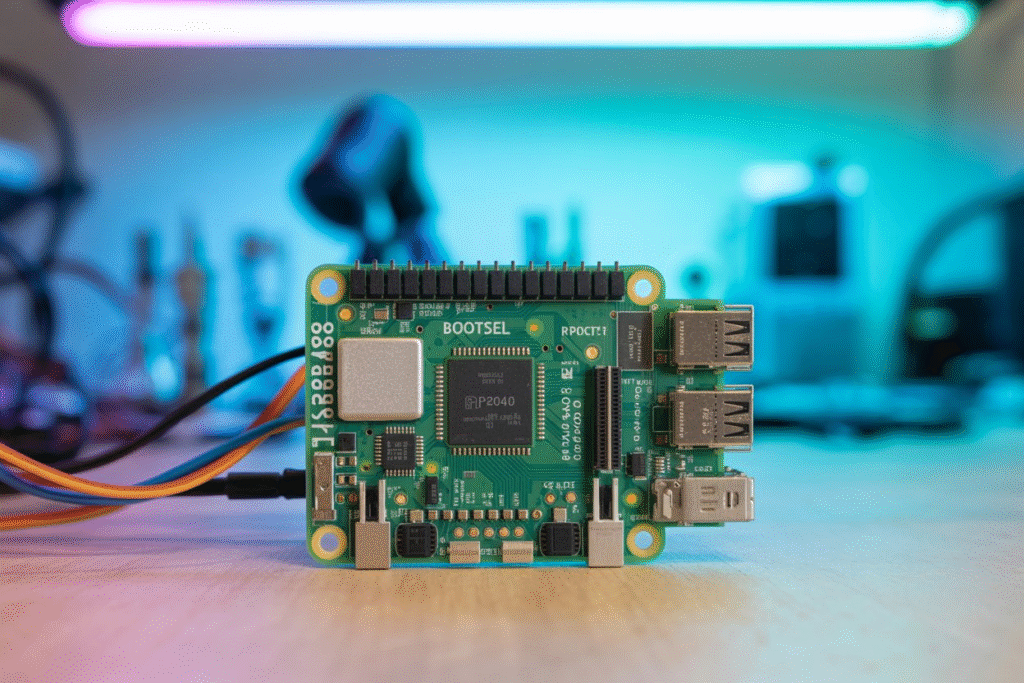
Introduction
Picture this: you’re excited to program your Raspberry Pi Pico, ready to bring your latest project to life. You connect the device, run a command, and then—bam!—you’re hit with the error “no accessible rp-series devices in bootsel mode were found.” It’s frustrating, but don’t worry. This common issue affects many working with RP2040-based boards, and it’s usually fixable. In this guide, we’ll break down what RP-series devices are, explain the role of BOOTSEL mode, and explore why this error occurs. Most importantly, we’ll provide clear, actionable steps to troubleshoot and resolve it, so you can get back to creating. Let’s dive into the world of microcontrollers and solve this problem together.
Understanding RP-Series Devices
What Are RP-Series Devices?
RP-series devices, primarily the RP2040 microcontroller, power a range of development boards like the Raspberry Pi Pico. Launched in 2021, the RP2040 is a dual-core Arm Cortex-M0+ processor running at up to 133 MHz. It offers 264KB of RAM and 2MB of flash memory, making it ideal for projects from simple LED displays to complex IoT applications. Its Programmable I/O (PIO) system allows custom protocols, adding flexibility for unique designs. The RP2040’s affordability and open-source support have made it a favorite among hobbyists and professionals. However, programming these devices requires understanding specific modes like BOOTSEL, which we’ll explore next.
Why Are They Popular?
The RP2040’s popularity stems from its balance of power, cost, and community support. Since its release, millions of Raspberry Pi Pico boards have been sold, fueling countless projects. Its dual-core architecture enables efficient multitasking, while 26 multifunction pins support various interfaces like I2C and SPI. The open-source ecosystem provides extensive documentation, libraries, and forums, making it accessible for beginners and advanced users alike. Yet, challenges like the “no accessible rp-series devices in bootsel mode were found” error can arise during programming. Understanding the device’s capabilities and limitations is key to overcoming such hurdles and maximizing its potential in your projects.

Applications of RP-Series Devices
RP2040-based boards are used in diverse applications, from robotics to wearable tech. For example, hobbyists create smart home devices, while educators use them to teach coding. The RP2040’s low power consumption suits battery-powered projects, and its PIO system enables custom communication protocols for niche applications. However, to leverage these capabilities, you need to program the device, often requiring BOOTSEL mode. When this mode fails, you might encounter the error we’re addressing. Knowing the RP2040’s versatility helps you appreciate why resolving this issue is worth the effort, as it unlocks a world of creative possibilities.
What is BOOTSEL Mode?
Definition and Purpose
BOOTSEL mode is a special state in the RP2040’s bootrom, allowing the device to act as a USB mass storage device. When activated, your computer sees the RP2040 as a drive (often labeled “RPI-RP2”), where you can drag and drop UF2 firmware files to update the device. This mode simplifies programming, eliminating the need for external programmers. It’s especially useful for beginners, as it makes firmware updates as easy as copying a file. However, if the device doesn’t enter BOOTSEL mode, you’ll likely see the error “no accessible rp-series devices in bootsel mode were found,” which we’ll address in detail.
How to Enter BOOTSEL Mode
On a standard Raspberry Pi Pico, entering BOOTSEL mode is straightforward:
- Locate the BOOTSEL button next to the USB connector.
- Hold the button down.
- Connect the Pico to your computer via USB.
- Release the button when the onboard LED blinks, indicating BOOTSEL mode.
For custom boards, the process may vary, depending on how the BOOTSEL pin (GP21) is configured. If this process fails, the error “no accessible rp-series devices in bootsel mode were found” may appear. Understanding the correct method for your specific board is crucial to avoid this issue and ensure smooth firmware updates.
Technical Details
When the RP2040 powers up, its bootrom checks the BOOTSEL pin (GP21). If the pin is low, the device enters BOOTSEL mode, initializing the USB interface as a mass storage device. The bootrom then waits for a UF2 file, which it loads into memory and executes. This process is seamless on standard boards but can fail on custom designs if the pin or USB lines are misconfigured. Such failures often trigger the error we’re discussing. Knowing these technical details helps you troubleshoot effectively, especially when dealing with non-standard hardware or complex setups.
Common Causes of the Error
Improper BOOTSEL Mode Entry
One of the most frequent causes of the “no accessible rp-series devices in bootsel mode were found” error is not entering BOOTSEL mode correctly. You must hold the BOOTSEL button firmly while connecting the USB cable and keep it pressed for a few seconds. Releasing too early or not pressing at all prevents the device from entering the mode. On custom boards, the BOOTSEL functionality might be mapped to a different pin or button, so check your board’s documentation. This simple mistake is often the culprit, but it’s easy to fix with proper technique.
USB Connection Issues
Faulty USB connections are another common reason for this error. A damaged cable, loose port, or low-quality USB hub can prevent your computer from detecting the RP2040. Additionally, outdated or missing USB drivers on your computer might cause recognition issues. If the device isn’t powered correctly, it may not initialize properly, leading to the error “no accessible rp-series devices in bootsel mode were found.” Testing with a different cable or port can quickly rule out this issue. Ensuring a stable, high-quality connection is essential for reliable communication with your RP2040 device.
Hardware Design Flaws
For custom RP2040-based boards, hardware design issues can block BOOTSEL mode. Common problems include incorrect BOOTSEL pin connections, missing pull-up resistors on USB D+ and D- lines, or inadequate power supply. For example, a user on the Raspberry Pi Forums reported that their custom board failed to enter BOOTSEL mode due to a misconfigured schematic. These issues often result in the error “no accessible rp-series devices in bootsel mode were found.” Carefully reviewing your board’s design against the RP2040 datasheet can help identify and fix such problems, ensuring proper functionality.
Software and Tool Incompatibilities
Outdated or incompatible software tools, like picotool, can trigger this error. For instance, an older version of picotool might not recognize the RP2040 correctly, leading to the message “no accessible rp-series devices in bootsel mode were found.” Similarly, operating system updates or missing drivers can cause conflicts. A Reddit user noted that updating their tools resolved similar issues. Always use the latest version of picotool and ensure your system’s USB drivers are up to date. This simple step can prevent many software-related problems when working with RP2040 devices.

Firmware or Device Conflicts
In rare cases, corrupted firmware or conflicting USB devices can cause this error. Custom firmware might alter the bootrom’s behavior, preventing BOOTSEL mode activation. Additionally, other USB devices connected to your computer might interfere with detection. A Stack Exchange post highlighted a case where a device was recognized but not in BOOTSEL mode due to firmware issues. Disconnecting other devices or resetting the RP2040 to its factory state can help. These scenarios are less common but worth checking if other troubleshooting steps fail.
Troubleshooting Steps
Verify BOOTSEL Mode Activation
Start by ensuring you’re entering BOOTSEL mode correctly. Hold the BOOTSEL button firmly while connecting the USB cable, and keep it pressed until the onboard LED blinks (on standard Pico boards). If the LED doesn’t blink, try again, ensuring a secure connection. For custom boards, consult your documentation to confirm the BOOTSEL pin or button. This step is critical, as improper technique is a leading cause of the “no accessible rp-series devices in bootsel mode were found” error. Double-checking your method can quickly resolve the issue and get your device recognized.
Check USB Recognition
Next, verify that your computer recognizes the RP2040. On Windows, open Device Manager; on macOS or Linux, use system tools to list USB devices. Look for a device labeled “RPI-RP2” or similar. If it’s missing, the issue might be with the USB connection or power supply. Try a different USB port or cable to rule out hardware faults. A user on GitHub reported that switching cables fixed their detection issue. If the device still isn’t recognized, the error “no accessible rp-series devices in bootsel mode were found” may indicate a deeper hardware or driver problem.
Use Picotool Commands
If the device is connected but not in BOOTSEL mode, try forcing it with picotool. Run the command:
picotool reboot -f -u
This forces the RP2040 to reboot into BOOTSEL mode. Be cautious, as forcing can cause issues if the device is unstable. A Stack Exchange user noted that this command didn’t work for them, suggesting hardware issues, but it’s worth trying. If successful, your computer should detect the device as a USB drive. If not, the error “no accessible rp-series devices in bootsel mode were found” persists, and you should explore other troubleshooting steps.
Update Tools and Drivers
Ensure you’re using the latest version of picotool, available from Raspberry Pi’s GitHub repository. Outdated tools can fail to recognize the RP2040, triggering the error. Also, update your operating system’s USB drivers. On Windows, check Device Manager for driver updates; on Linux, ensure libusb is installed. A Reddit post mentioned that updating picotool resolved a similar issue. Keeping your software current prevents many errors, including “no accessible rp-series devices in bootsel mode were found.” This step is simple but effective, ensuring compatibility between your tools and the RP2040 device.
Inspect Custom Hardware
For custom RP2040 boards, hardware issues are a common culprit. Check your schematic against the RP2040 datasheet, focusing on:
- BOOTSEL Pin (GP21): Ensure it’s correctly connected to a button or pull-down resistor.
- USB Lines: Verify D+ and D- lines have 27-ohm series resistors and a 1.5k pull-up on D+.
- Power Supply: Confirm the board receives 3.3V or 5V as required.
A Raspberry Pi Forums user found that a missing pull-up resistor caused their error. Fixing these issues can resolve the “no accessible rp-series devices in bootsel mode were found” problem, making your custom board fully functional.
Reset to Factory State
If all else fails, reset the RP2040 to its factory state. Hold both the BOOTSEL and RUN buttons while connecting USB, then release RUN but keep BOOTSEL pressed. This erases user code and restores default firmware. A GitHub issue noted this method helped when firmware corruption caused the error. After resetting, try entering BOOTSEL mode again. If the error “no accessible rp-series devices in bootsel mode were found” persists, your device might be faulty, and you should test with another board or seek community help.
| Troubleshooting Step | Description | Common Issues Addressed |
|---|---|---|
| Verify BOOTSEL Mode | Hold BOOTSEL button while connecting USB | Incorrect button usage |
| Check USB Recognition | Look for device in Device Manager | Faulty cables/ports |
| Use Picotool Commands | Run picotool reboot -f -u | Device not in BOOTSEL mode |
| Update Tools/Drivers | Install latest picotool and drivers | Software incompatibilities |
| Inspect Custom Hardware | Check schematic for pin and USB issues | Hardware design flaws |
| Reset to Factory | Hold BOOTSEL and RUN buttons | Firmware corruption |
Solutions and Workarounds
Drag-and-Drop UF2 Files
If you can manually enter BOOTSEL mode, use the drag-and-drop method to flash firmware. When the device appears as a USB drive, copy a UF2 file onto it. The RP2040 will automatically load and run the file. This method bypasses picotool issues and is ideal for simple updates. Ensure your UF2 file is compatible with your board. A Reddit user reported success with this approach despite the error “no accessible rp-series devices in bootsel mode were found.” It’s a reliable workaround when BOOTSEL mode works but picotool fails.
SWD Debugging
For persistent issues, use an SWD debugger, like the Raspberry Pi Debug Probe. This allows direct programming without BOOTSEL mode, using tools like OpenOCD or VS Code’s debugging features. Connect the debugger to the RP2040’s SWD pins (SWDIO, SWCLK, GND) and follow your tool’s setup guide. A user on the Raspberry Pi Forums used SWD to bypass BOOTSEL issues on a custom board. This method requires extra hardware but avoids the “no accessible rp-series devices in bootsel mode were found” error, making it a robust solution for advanced users.

Alternative Boot Modes
The RP2040 supports other boot modes, like booting from SPI flash, though these are less常见的 for standard use. If your project allows, configure your hardware to boot from an external flash chip. This requires advanced setup and isn’t ideal for beginners. Most users should stick to BOOTSEL or SWD methods. However, exploring alternative modes can help if hardware limitations cause the error “no accessible rp-series devices in bootsel mode were found.” Consult the RP2040 datasheet for details on implementing these modes correctly.
Community Support
Online communities are invaluable for resolving this error. Post your issue on the Raspberry Pi Forums, Reddit’s r/raspberrypipico, or Stack Exchange. Include details like your board type, operating system, and steps tried. A GitHub issue thread showed users sharing solutions for similar problems. These platforms offer insights from experienced developers, helping you overcome the “no accessible rp-series devices in bootsel mode were found” error. Engaging with the community not only solves your issue but also connects you with others passionate about RP2040 projects.
Pros and Cons of Troubleshooting Methods
| Method | Pros | Cons |
|---|---|---|
| Drag-and-Drop UF2 | Simple, no extra hardware needed | Requires manual BOOTSEL entry |
| SWD Debugging | Reliable, bypasses BOOTSEL issues | Needs additional hardware, complex setup |
| Alternative Boot Modes | Flexible for advanced users | Not beginner-friendly, requires hardware changes |
| Community Support | Free, diverse solutions | May require waiting for responses |
Preventing Future Issues
Know Your Hardware
Familiarize yourself with your board’s BOOTSEL mechanism. Standard Pico boards use a button, but custom boards may differ. Check documentation to avoid errors like “no accessible rp-series devices in bootsel mode were found.” Understanding your hardware prevents common mistakes.
Keep Tools Updated
Regularly update picotool and your operating system’s drivers. New versions fix bugs and improve compatibility, reducing the chance of errors. A Reddit user noted that updating tools resolved their issue quickly.
Test Custom Designs
For custom boards, prototype and test thoroughly. Use simulation tools to verify BOOTSEL and USB functionality. This prevents design flaws that trigger the error.
Use Quality Connections
Invest in reliable USB cables and avoid hubs. Direct connections to your computer minimize issues, ensuring your device is detected correctly.
FAQs
What is BOOTSEL mode?
BOOTSEL mode allows the RP2040 to act as a USB drive for firmware updates, simplifying programming without extra hardware.
Why does my device not enter BOOTSEL mode?
It could be due to incorrect button usage, faulty USB connections, hardware design issues, or outdated software.
Can I program without BOOTSEL mode?
Yes, use SWD debugging or alternative boot modes, though they require more setup.
How do I force BOOTSEL mode?
Run picotool reboot -f -u, but use cautiously to avoid potential issues.
Conclusion
The error “no accessible rp-series devices in bootsel mode were found” can feel like a roadblock, but it’s a solvable challenge. By understanding RP-series devices, mastering BOOTSEL mode, and following our troubleshooting steps, you can get your Raspberry Pi Pico or custom board back on track. Whether you’re flashing firmware or building complex projects, persistence is key. Don’t let this error stop you—try our solutions, engage with the maker community, and keep creating. Ready to conquer this issue? Grab your Pico, follow this guide, and make something extraordinary today!


